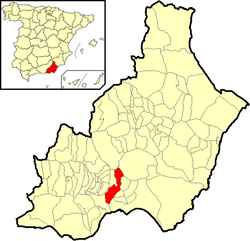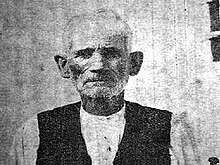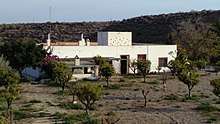Crime of Gádor
The crime of Gádor was the name given to the kidnapping and subsequent murder of a seven-year-old boy by Francisco Leona in Gádor, Almería. The purpose of the crime was to use the child's blood and body fat as a folk cure for a wealthy patron's tuberculosis.[1]
| Crime of Gádor | |
|---|---|
 Cortijo de San Patricio, where the murder occurred | |
 Location of Gádor | |
| Coordinates | |
| Date | June 28, 1910 |
Attack type | Kidnapping |
| Weapons | Knife and stone |
| Victims | Bernardo Gonzalez Parra |
| Perpetrators |
|
| Verdict | Guilty |
Background

At the time, it was believed that drinking the blood of a human child and using their body fat as cataplasm was a remedy for tuberculosis.[2]
Francisco Ortega El Moruno (The Moor) had recently been diagnosed with tuberculosis and was desperately seeking a cure.[3] He visited the local curandera Agustina Rodriguez, who in turn sent for the barber and healer Francisco Leona.[3] Leona, who also had a criminal record, agreed to cure Ortega in exchange for 3000 reales.[3]
Leona and Julio El Tonto (The Fool) Hernández, a son of Agustina the healer, offered to find a child. On the evening of June 27, 1910, Francisco Leona kidnapped Bernardo Gonzalez Parra, a seven year old from Rioja, drugged him with chloroform and put him in a sack.[4]
Murder
A brother of Julio "Tonto" Hernández, Joseph Hernández, was to advise the client Ortega, leaving his wife Elena to make dinner.
Little Bernardo's murder was as follows: after he was removed from the sack, dazed, Bernardo was stabbed in the heart by Leona, and Ortega mixed his blood with sugar and drank it.[4] After that they took the boy to a place known as Las Pocicas where Leona killed him, crushing his skull with a rock. Then he extracted fat and mesentery to make a compress to apply to Ortega's chest.
To finish the ritual, Bernardo's body was concealed in a crevice, unburied but covered with herbs and stones, located in Las Pocicas.
When distributing the actual 3000 Ortega paid him for his services, the healer Leona tried and failed to trick his accomplice Tonto Hernández. Realizing Leona's intentions, Hernández told the Civil Guard who had seen the body of a child while he was chasing partridges.
Judicial and police intervention

When law enforcement officers arrived, the people of Gádor turned Leona over to them, as he was known for his illegal and occult practices.[5] During court proceedings, Leona indicted el Tonto Hernández in his testimony, who in turn did the same to Leona.[5] Finally, after multiple excuses, both confessed to the crime.[6]
Most of the perpetrators were executed by hanging.[4] Leona was sentenced to death by garrote, but died in prison.[7] The client, Ortega, and Agustina, the curandera, were both sentenced to death.[7] Joseph Hernández, was sentenced to 17 years in prison while his wife, Elena, was acquitted. Julio el Tonto was sentenced to death too, but received a pardon on grounds of insanity following a psychiatric report.[7][8][9]
Aftermath
This crime gave rise to the terms Hombre del saco and Sacamantecas,[10] because the kidnapers used a gunny sack to carry the children.[11] It was defined as "medical crime," inspired by folk beliefs about the medicinal properties of human blood and children's manteca.[12]
A TV episode named El sacamantecas was released in 1986.[13] A documentary directed by Juan Francisco Viruega and named La cicatriz was released on 21 November 2019 during the Festival de Cine de Almería.[14][15]
References
- Jiménez Elizari, Iker (April 6, 2006). "Jáncanas y brujas: Señoras de la magia". El paraíso maldito. EDAF. p. 199. ISBN 9788441417724.
- Costa, Pedro (January 1, 2006). Caño, Antonio (ed.). "La vampira del carrer Ponent". El País (in Spanish). Ediciones El País, S.L. ISSN 0213-4608. Retrieved March 27, 2018.
- Sanz y Díaz, José (1984). "Etnografía negra. El crimen que dio lugar a la leyenda de "El Sacamantecas"". Revista de Folklore. Valladolid. 4b (47): 171–174. Retrieved March 27, 2018.
- Fernández Juárez 2008, p. 22.
- García Bautista 2015, p. 16.
- García Bautista 2015, p. 17.
- García Bautista 2015, p. 18.
- Soler Cervantes, Milagros. "El crimen de Gádor (Almería)". Cultura en Andalucía (in Spanish). Retrieved February 22, 2015.
- Gómez Aracil, Miguel (November 25, 2009). Vampiros: Mito y realidad de los no muertos. EDAF. p. 139. ISBN 9788441421622.
- Ayala Sörense, Federico (September 25, 2014). Expósiot, Ángel (ed.). "El verdadero "Hombre del Saco"". ABC (in Spanish). Diario ABC, S.L. Retrieved March 27, 2018.
- Fernández Juárez 2008, p. 61.
- Caro Baroja, Julio. "Notas de viajes por Andalucía". In Carreira, Antonio (ed.). De etnología andaluza. Diputación Provincial de Málaga. p. 179.
- "Página de sucesos - El sacamantecas". Radio Televisión Española (in Spanish). 10 January 1986. Retrieved 10 August 2018.
- "'La cicatriz' del crimen de Gádor en un documental". La Voz de Almería. 6 July 2019. Retrieved 19 July 2019.
- Pérez, R. (2 November 2019). "«El sacamantecas», un crimen aterrador después de un siglo". ABC (in Spanish). Vocento. Retrieved 21 November 2019.
Bibliography
- Fernández Juárez, Gerardo (2008). Kharisiris en acción: cuerpo, persona y modelos médicos en el Altiplano de Bolivia. Editorial Abya Yala. p. 283. ISBN 9789978227213.CS1 maint: ref=harv (link)
- García Bautista, José Manuel (June 16, 2015). Guía de la Andalucía mágica: Lugares legendarios y paranormales del sur de España. Grupo Planeta Spain. pp. 15–18. ISBN 9788415864714.CS1 maint: ref=harv (link)